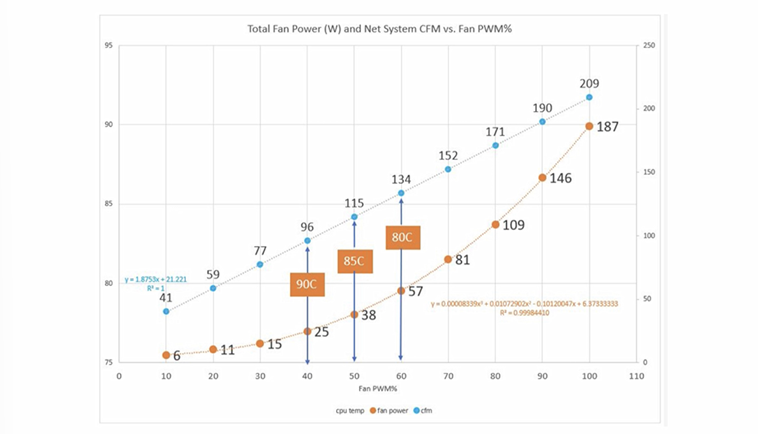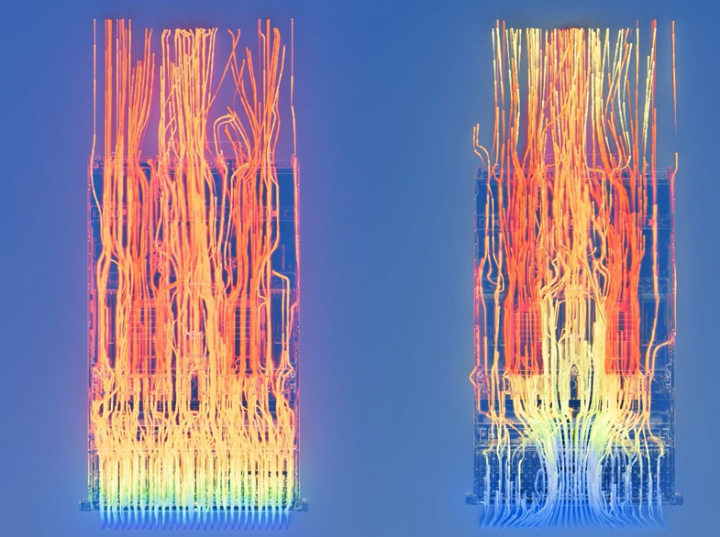In the fast-paced realm of data-driven businesses, achieving a competitive edge is crucial. Customers are now seeking innovative cooling solutions that not only defer the hefty investment in liquid cooling but also enable them to stay ahead of the game. Discover how cost-effective, intelligent air-cooling technology can help you maintain your competitive edge without compromising on performance.
Efficient Fan Power Management
A primary concern for customers is power consumption, as it directly impacts operational costs. And fan power can be a significant chunk of wasted power in the server box. By modulating fan speeds, Dell Technologies helps minimize power waste while still delivering optimal cooling performance.
PowerEdge servers include Smart Cooling technology, which is comprised of intelligent fan control algorithms that work in unison to maintain the lowest possible fan power state without sacrificing cooling or the reliability of the server. By running fans at the lowest possible speed while maintaining optimal cooling, Dell minimizes fan power consumption, resulting in overall operational cost reductions and more sustainable data center infrastructure.
Fan speed has a significant impact on power consumption. In fact, optimal fan control can reduce waste system power consumption. In figure 1 we see the relationship between fan speed and net system airflow consumption. Based on our analysis, we found that cooling to 90 degrees Celsius uses 25W fan power, 22W less than at 80 degrees Celsius and CPU reliability remains unaffected between 90 degrees and 80 degrees Celsius cooling.

AI-Modulated Cooling Ensures Optimal Performance
Maintaining optimal cooling performance helps prevent system overheating and ensures the longevity of server components. Dell’s proprietary AI-based fuzzy logic controller for closed-loop thermal management via fan and power controls, embedded in iDRAC (Integrated Dell Remote Access Controller), and extensive sensor integration, plays a vital role in achieving reliable and efficient cooling. The server systems are equipped with an array of between 50 and 70 sensors, monitoring critical components such as system inlet ambient, CPU, memory, storage devices, PSU (power supply units), I/O sub-systems and exhaust temperatures. Leveraging these sensor readings, the controller fine-tunes fan speeds to maintain optimal cooling without compromising fan and ultimately server reliability. Customers can enjoy enhanced performance and productivity, with the peace of mind that their servers are protected from overheating-related issues, with optimized fans that cool efficiently. 
Maximizing Return on Investment
Dell’s commitment to maximizing return on investment resonates strongly with customers. Understanding that not all customers can afford to or want to implement a liquid cooling infrastructure, Dell has designed our Smart Cooling solutions to be highly efficient. By leveraging existing infrastructure and optimizing fan control and power consumption, Dell enables customers to achieve high performance without immediate infrastructure upgrades. This approach eliminates the need for costly liquid cooling investments and allows customers to make the most of their current data centers. With Dell’s air-cooled servers, customers can strike a balance between performance and cost efficiency, ensuring their investments deliver long-term value.
Smart Flow Optimized Airflow Design
Another notable differentiator is Dell’s new airflow-optimized configuration. By employing a Smart Flow configuration, Dell creates an exclusive airflow channel in the server, that enables efficient cooling even with high-end CPUs that others can only cool via liquid cooling. This design innovation provides customers with the advantage of deploying high-performance CPUs while still utilizing air cooling and eliminating the need for costly infrastructure upgrades to liquid cooling. The selection of Smart Flow chassis is automatic based on system hardware configuration.


Put PowerEdge Servers to Work for You
Integrated with thermal and cooling expertise, PowerEdge servers deliver tangible solutions for customers challenged with how to efficiently air cool their server infrastructure. By optimizing power consumption through advanced fan control, comprehensive sensor integration and innovative airflow designs, Dell ensures maximum performance and efficiency of the server portfolio, without compromising reliability. Using PowerEdge servers with Smart Cooling technology, customers can minimize operational expenses, enhance productivity and build a sustainable and air-cooled data center infrastructure. By choosing PowerEdge servers, customers gain a competitive edge through improved performance, cost efficiency, scalability and sustainability, ultimately driving their success in a data-driven world.
Learn more about how PowerEdge thermal design saves power without sacrificing performance.
Explore the exceptional performance and durability of Dell PowerEdge servers.


